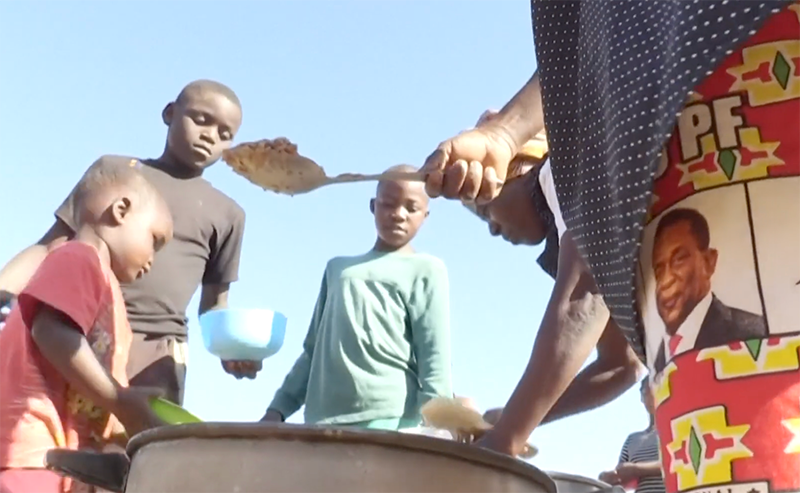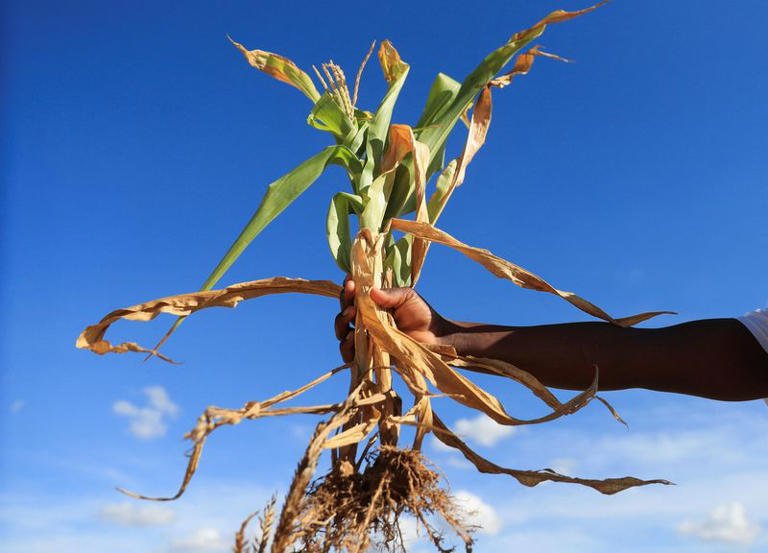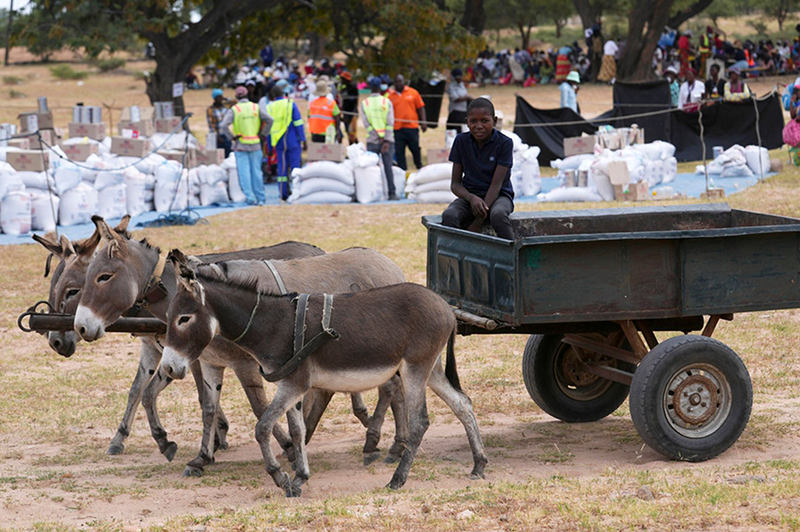- World & Africa
- No Comment
Hunger and unemployment: Drought delivers twin problem to southern Africa

By Kitsepile Nyathi I Nation Media Group
The El-Nino induced drought sweeping through southern Africa is taking a toll on the region’s economies with Zambia and Zimbabwe the biggest. The two countries major source of source of electricity is drying up, forcing them into rationing.
But that has also had a bigger twin problem: power rationing is likely to reduce the working hours for most informal sector operators, forcing them to shed casual labourers. In countries that heavily rely on agriculture and mining, electricity is an important source of energy to fuel the sectors.
Low rains have also meant low yields from what was once a region that fed other parts of the continent. Zambia, Zimbabwe, Malawi and Mozambique have recently faced floods, storms and now drought, all blamed on climate change.
Between Zambia and Zimbabwe, rolling power cuts lasting over 12 hours a day are choking industries and disrupting the dominant informal economies of both countries.
Zimbabwe and Zambia’s shared main source of hydropower, Kariba Dam, which is the world’s largest man-made reservoir, is holding only 10.01 percent of usable water for power generation compared to 28.54 percent during the same period last year, an update by the Zambezi River Authority (ZRA) showed on Tuesday.
ZRA, which is owned by both countries, monitors and regulates the water level in Kariba Dam.
The World Bank estimates that the prolonged load shedding, or power rationing, will cost Zimbabwe about eight percent of its gross domestic product this year.
“Power shortages have a significant adverse impact on the productive sector and result in higher costs for Zimbabwe’s economy,” the World Bank said in its recent Zimbabwe economic update.
“Electricity deficits are particularly damaging for the mining sector, given its highly energy-intensive characteristics, so that unreliable and expensive electricity supplies reduce the margins of existing operations and weigh heavily on the feasibility evaluations for expansions and new projects.

“Power shortages also significantly hurt the agriculture and agroprocessing sector by undermining irrigation, together with cold chain and storage facilities.
“Tourism is also affected as hotels, resorts and tourist attractions face disruption of essential services.”
Zambia is also battling surging inflation as the effects of the electricity shortages begin to impact on businesses.
The Famine Early Warning Systems Network (FewsNet) in its outlook for southern Africa issued on August 13 said the receding water levels at Kariba Dam spelt doom for the region.
“Additionally, the Kariba reservoir – a critical water source that also generates electricity, particularly in Zimbabwe and Zambia – is only around 11 percent full (477 m) and close to the minimum operating level of 475.5 m as of late July due to the poor recharge of water sources through the 2023/24 season,” FewsNet said.
“More frequent and extended power cuts (rolling blackouts) will likely affect industrial and general economic activity, which will in turn likely disrupt household income-generating opportunities from off-own-farm sources.”
The Zimbabwe Coalition on Debt and Development (ZIMCODD), a socio-economic justice network, said the electricity deficit blamed on climatic shocks was crippling industry and poor households.
“The country is experiencing prolonged load-shedding schedules, averaging 12 hours daily in many areas nationwide,” ZIMCODD said.
“This is crippling the domestic industry and poor households, who cannot afford alternatives.

“This is because the prices of electricity substitutes such as liquefied petroleum gas and fuel (petrol and diesel) remain highly elevated, sustained by deteriorating global geopolitics and resultant geo-economic fragmentation.
“The power shortages will also likely exert a knock-on-effect on winter wheat farming, causing temporary commercial and communications disruptions, traffic congestion, banking disruptions and increasing security threats.”
Christopher Mugaga, the Zimbabwe National Chamber of Commerce CEO, said power outages were weighing heavily on industry.
“The impact is far reaching. We are looking at its impact on winter wheat farming and its impact in terms of companies’ operational hours,” Mr Mugaga said.
“We are losing an average of eight to 12 hours of power daily. That alone has an impact in terms of production capacity, in terms of capacity utilisation and planning.
“We cannot talk of industrialisation without addressing power cuts.”
For Zimbabwe, hydroelectricity is critical as it accounts for at least 15 percent of the country’s energy supply mix.
Zimbabwe’s Energy and Power Development minister Edgar Moyo said the drop in water levels at Kariba Dam had resulted in the loss of 800 megawatts.
“The issue of power supply in the country is heavily affected by hydrological issues in Lake Kariba where we have lost over 800 megawatts,” Mr Moyo told Parliament.
“The stored capacity at Kariba is 1 050 megawatts and we are only able to produce 214 megawatts on average because of the water rationing, which has resulted from low inflows into the lake.
“In that perspective, losing over 800 megawatts makes it very difficult to sufficiently supply power in the country.”
Zimbabwe is slightly better off than Zambia because it has in the past few years invested in coal-fired power stations with loans from China, which has made it possible to sell some power to its neighbour even amid the crisis.
Zambia’s Energy minister Makozo Chikote recently announced that the country’s state-owned power utility ZESCO will buy 218 megawatts of electricity from South Africa and Zimbabwe to cushion the shortfall caused by reduced hydropower capacity.
The country has a deficit of more than 1 000 megawatts. Zambia gets 75 percent of its electricity from hydropower stations, with the Kariba power station being the largest.
Malawi, Namibia, Zambia and Zimbabwe are the southern African countries that issued drought-related disaster declarations this year following the drought that has been described as the worst in 100 years in some parts of the region.
Besides the devastation to their economies, the countries are scrambling for resources to feed over 30 million people that are facing starvation due to the drought, FewsNet said.
“Most of Zimbabwe, southern Malawi, southern and central Mozambique, southern Angola and conflict-affected areas of the Democratic Republic of Congo are of highest concern,” it added.
“A historic dry spell and above-average temperatures in early 2024 led to well below-average maize harvests across the region ranging from a 10 percent deficit in South Africa to a 60 percent deficit in Zimbabwe compared to their respective five-year averages, according to national government and FewsNet estimates.”
The region is a deficit of three million tonnes of the staple and imports from South America are expected to plug the gap, but has already driven prices through the roof in some countries.
“While several countries are in the process of securing contracts to import maize from international markets, particularly in South America, constrained regional market supply is driving inflated maize prices, with prices in most markets trending well above both last year and the five year-average despite seasonal declines in the post-harvest period,” FewsNet added.
“In Malawi and Zimbabwe, for example, maize grain prices are already around 130-150 percent above average for this time of the year.”
The Southern African Development Community says it needs about $5.5 billion for drought relief efforts in the region and also to help countries recover from the effects of floods.
